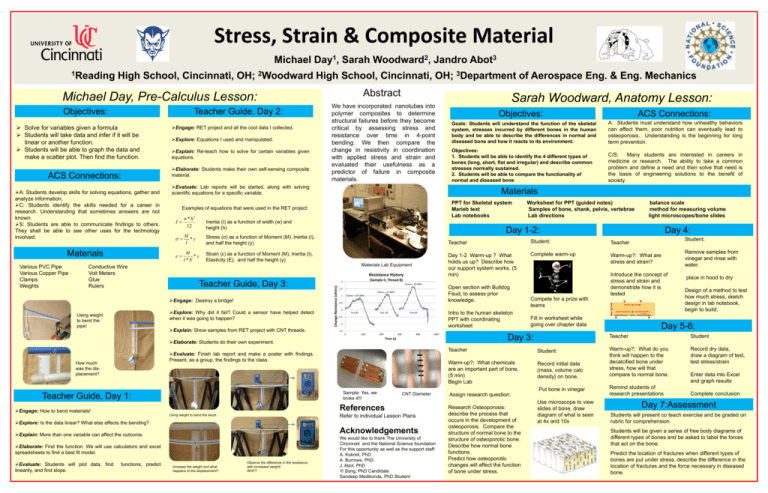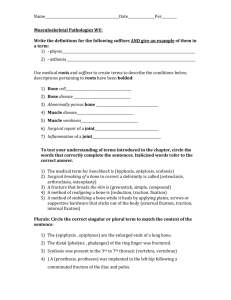Project 3 Classroom Implementation Plan Posters
advertisement

Stress, Strain & Composite Material Michael 1Reading High School, Cincinnati, OH; 1 Day , 2Woodward Sarah Teacher Guide, Day 2: ACS Connections: A: Students develop skills for solving equations, gather and analyze information, C: Students identify the skills needed for a career in research. Understanding that sometimes answers are not known. S: Students are able to communicate findings to others. They shall be able to see other uses for the technology involved. Materials Various PVC Pipe Various Copper Pipe Clamps Weights Conductive Wire Volt Meters Glue Rulers Engage: RET project and all the cool data I collected. Explore: Equations I used and manipulated. Explain: Re-teach how to solve for certain variables given equations. Elaborate: Students make their own self-sensing composite material. We have incorporated nanotubes into polymer composites to determine structural failures before they become critical by assessing stress and resistance over time in 4-point bending. We then compare the change in resistivity in coordination with applied stress and strain and evaluated their usefulness as a predictor of failure in composite materials. Inertia (I) as a function of width (w) and height (h) M *y I Stress (σ) as a function of Moment (M), Inertia (I), and half the height (y) M *y I *E Strain (ε) as a function of Moment (M), Inertia (I), Elasticity (E), and half the height (y) M* h 3 w **yy I *I12 E I Explain: Show samples from RET project with CNT threads. 2 Stress = 20 MPa Stress = 15 MPa Stress = 10 MPa 1 0.5 0 Test #2 Test #3 Objectives: 1. Students will be able to identify the 4 different types of bones (long, short, flat and irregular) and describe common stresses normally sustained. 2. Students will be able to compare the functionality of normal and diseased bone C/S: Many students are interested in careers in medicine or research. The ability to take a common problem and define a need and then solve that need is the basis of engineering solutions to the benefit of society. -0.5 -1 200 400 600 800 CNT Diameter Explore: Is the data linear? What else effects the bending? Acknowledgements Elaborate: Find the function. We will use calculators and excel spreadsheets to find a best fit model. Increase the weight and what happens to the displacement? Observe the difference in the resistance with increased weight! WHY? Day 1-2 Warm-up ? What holds us up? Describe how our support system works. (5 min) Complete warm-up Teacher We would like to thank The University of Cincinnati and the National Science foundation For this opportunity as well as the support staff: A. Kukreti, PhD A. Burrows, PhD J. Abot, PhD Yi Song, PhD Candidate Sandeep Medikonda, PhD Student Remove samples from vinegar and rinse with water. Warm-up?: What are stress and strain? Compete for a prize with teams Fill in worksheet while going over chapter data Teacher Student: Warm-up?; What chemicals are an important part of bone, (5 min) Begin Lab Record initial data (mass, volume calc density} on bone, Put bone in vinegar Assign research question: Research Osteoporosis: describe the process that occurs in the development of osteoporosis. Compare the structure of normal bone to the structure of osteoporotic bone. Describe how normal bone functions. Predict how osteoporotic changes will affect the function of bone under stress. Student: Introduce the concept of stress and strain and demonstrate how it is tested Day 3: Time (s) Refer to individual Lesson Plans Explain: More than one variable can affect the outcome. Teacher 1000 References Using weight to bend the wood. balance scale method for measuring volume light microscopes/bone slides Day 4: Use microscope to view slides of bone, draw diagram of what is seen at 4x and 10x place in hood to dry Design of a method to test how much stress, sketch design in lab notebook, begin to build. Day 5-6: -1.5 Sample: Yes, we broke it!!! Engage: How to bend materials! Worksheet for PPT (guided notes) Samples of bone, shank, pelvis, vertebrae Lab directions Student: Intro to the human skeleton PPT with coordinating worksheet Test #4 Evaluate: Finish lab report and make a poster with findings. Present, as a group, the findings to the class. functions, predict A: Students must understand how unhealthy behaviors can affect them, poor nutrition can eventually lead to osteoporosis. Understanding is the beginning for long term prevention. Open section with Bulldog Feud, to assess prior knowledge. 1.5 Elaborate: Students do their own experiment. Teacher Guide, Day 1: ACS Connections: Goals: Students will understand the function of the skeletal system, stresses incurred by different bones in the human body and be able to describe the differences in normal and diseased bone and how it reacts to its environment. (Sample II, Thread B) 0 Evaluate: Students will plot data, find linearity, and find slope. Objectives: Day 1-2: Resistance History Explore: Why did it fail? Could a sensor have helped detect when it was going to happen? How much was the displacement? Sarah Woodward, Anatomy Lesson: PPT for Skeletal system Marieb text Lab notebooks Materials Lab Equipment Teacher Guide, Day 3: of Aerospace Eng. & Eng. Mechanics Materials Examples of equations that were used in the RET project: Engage: Destroy a bridge! Using weight to bend the pipe! 3Department Evaluate: Lab reports will be started, along with solving scientific equations for a specific variable. w * h3 I 12 3 Abot Abstract Change Resistance (ohms) Solve for variables given a formula Students will take data and infer if it will be linear or another function. Students will be able to graph the data and make a scatter plot. Then find the function. Jandro High School, Cincinnati, OH; Michael Day, Pre-Calculus Lesson: Objectives: 2 Woodward , Teacher Student Warm-up?; What do you think will happen to the decalcified bone under stress, how will that compare to normal bone. Record dry data, draw a diagram of test, test stress/strain Remind students of research presentations Enter data into Excel and graph results Complete conclusion Day 7:Assessment Students will present co teach exercise and be graded on rubric for comprehension. Students will be given a series of free body diagrams of different types of bones and be asked to label the forces that act on the bone. Predict the location of fractures when different types of bones are put under stress, describe the difference in the location of fractures and the force necessary in diseased bone.







